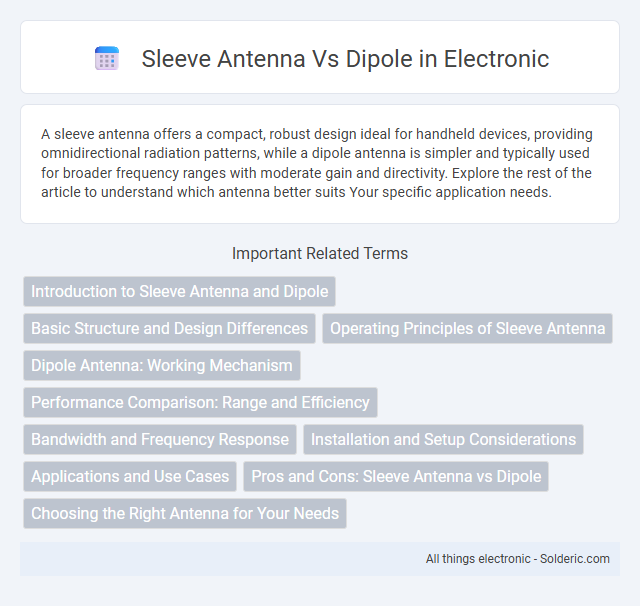A sleeve antenna offers a compact, robust design ideal for handheld devices, providing omnidirectional radiation patterns, while a dipole antenna is simpler and typically used for broader frequency ranges with moderate gain and directivity. Explore the rest of the article to understand which antenna better suits Your specific application needs.
Comparison Table
| Feature | Sleeve Antenna | Dipole Antenna |
|---|---|---|
| Structure | Coaxial feed with a conductive sleeve around the outer conductor | Two equal-length conductive elements aligned end-to-end |
| Polarization | Vertical polarization | Typically horizontal polarization, but can be vertical |
| Impedance | Approximately 50 O, well matched to coaxial cable | Approximately 73 O in free space |
| Bandwidth | Narrow to moderate bandwidth | Moderate bandwidth, can be enhanced with design variations |
| Radiation Pattern | Omnidirectional in horizontal plane | Bidirectional broadside radiation pattern |
| Applications | VHF/UHF communications, base stations, mobile radios | Wide-ranging: broadcast, HF/VHF/UHF communications, reference antenna |
| Size | Compact, sleeve reduces antenna length | Typically half-wavelength long, larger size |
| Installation | Simple, vertical mounting on coax cable | Requires supporting structure at center or ends |
| Cost | Cost-effective for specific frequency bands | Generally low cost and easy to build |
Introduction to Sleeve Antenna and Dipole
A sleeve antenna consists of a coaxial feed line surrounded by a conductive sleeve, offering improved impedance matching and bandwidth compared to standard dipole antennas, which are simple wire elements typically half the wavelength of the operating frequency. Dipole antennas are widely used in communication systems for their omni-directional radiation pattern and straightforward design, while sleeve antennas provide enhanced performance in compact spaces and applications requiring robust signal quality. Understanding the structural differences helps in selecting the appropriate antenna for specific frequency ranges and installation constraints.
Basic Structure and Design Differences
Sleeve antennas feature a conductive sleeve connected to a coaxial feed line, acting as a quarter-wave resonator designed primarily for vertical polarization and omnidirectional patterns, while dipole antennas consist of two symmetrical conductive elements forming a half-wave resonator that supports linear polarization. The sleeve antenna integrates the radiator and matching section in a compact cylindrical form, enhancing durability and reducing environmental interference, whereas the dipole relies on its open-wire or rod structure, which may require external supports and tuning. Your choice depends on space constraints and polarization needs, with sleeve antennas offering a more robust, integrated design compared to the simple, versatile layout of dipoles.
Operating Principles of Sleeve Antenna
Sleeve antennas operate based on a quarter-wavelength monopole design with a conductive sleeve acting as a ground plane, enhancing impedance matching and bandwidth. The sleeve surrounds the radiating element, creating a balanced feed that reduces surface currents and improves radiation efficiency. This structure enables the antenna to achieve omnidirectional radiation patterns similar to dipole antennas but with a more compact and robust form factor.
Dipole Antenna: Working Mechanism
The dipole antenna operates by converting electrical signals into radio waves through two conductive elements that resonate at a specific frequency, creating an oscillating current. Each element, typically a half-wavelength long, radiates electromagnetic energy efficiently in a broadside pattern, enabling effective transmission and reception. This simple structure allows the dipole to provide a balanced impedance and strong directional radiation, making it ideal for various wireless communication applications.
Performance Comparison: Range and Efficiency
Sleeve antennas typically offer improved bandwidth and better impedance matching compared to dipole antennas, resulting in more stable performance across a wider frequency range. Dipole antennas generally provide higher gain and longer range in ideal line-of-sight conditions due to their simpler design and direct radiation pattern. Your choice between a sleeve and dipole antenna should consider specific application requirements, including desired range, efficiency, and environmental factors impacting signal propagation.
Bandwidth and Frequency Response
Sleeve antennas offer narrow bandwidth but provide stable frequency response, making them suitable for specific narrowband applications. Dipole antennas typically exhibit wider bandwidth and more versatile frequency response, accommodating a broader range of frequencies with consistent performance. Bandwidth efficiency of dipoles makes them preferred for multi-frequency communication systems compared to the more frequency-selective sleeve antennas.
Installation and Setup Considerations
Sleeve antennas offer straightforward installation with a single mounting point and simpler feedline connections, making them ideal for constrained spaces and quick setup. Dipole antennas require precise alignment of two conductive elements and balanced feedline attachments, demanding more space and careful tuning to achieve optimal performance. Both antenna types benefit from proper grounding and height positioning to maximize signal strength and minimize interference during setup.
Applications and Use Cases
Sleeve antennas are widely used in VHF and UHF applications such as handheld radios, base stations, and marine communication due to their compact size and omnidirectional radiation pattern. Dipole antennas find extensive use in wireless communication systems, broadcast radio, and amateur radio because of their simple design and efficient transmission of balanced signals. Both antennas serve critical roles in telecommunications, but sleeve antennas excel in portable and fixed setups requiring durability and ease of installation, while dipoles dominate in scenarios demanding high gain and straightforward construction.
Pros and Cons: Sleeve Antenna vs Dipole
Sleeve antennas offer a compact design with good impedance matching and are less affected by nearby objects, making them ideal for limited space applications. Dipole antennas provide wider bandwidth and higher gain but require more space and are more susceptible to environmental interference. Your choice depends on the balance between size constraints, performance needs, and installation environment.
Choosing the Right Antenna for Your Needs
Selecting the right antenna depends on factors like frequency range, size constraints, and application environment. Sleeve antennas offer compact design and omnidirectional patterns ideal for portable or space-limited devices, while dipole antennas provide higher gain and broader bandwidth suited for fixed installations and longer ranges. Evaluate your signal coverage needs and physical space to ensure your antenna choice optimizes performance and connectivity.
sleeve antenna vs dipole Infographic

 solderic.com
solderic.com